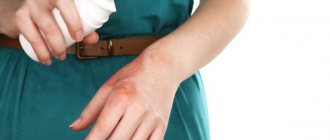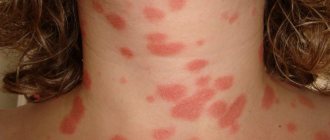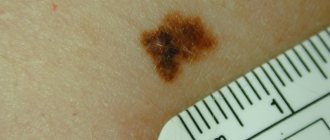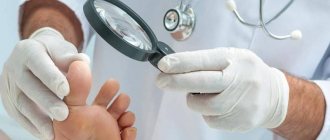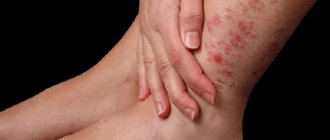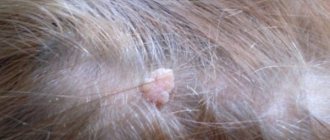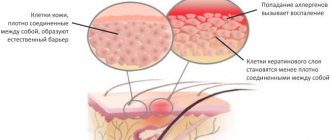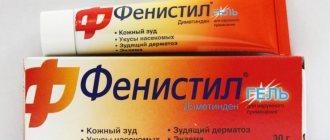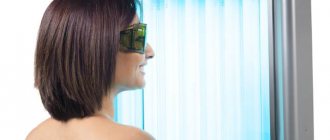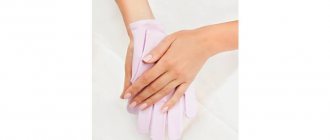Psoriasis of the scalp is a non-infectious skin disease. It is not transmitted through person-to-person contact and is most often a genetic predisposition. Psoriasis on the scalp looks like scaly red patches. Most often it occurs on the scalp.
During the period of relapses, a person develops itching, peeling and redness of the area increases. This period usually occurs in spring and autumn. This disease does not pose a threat to health, but the disease itself very often becomes the cause of complexes and depression, since the appearance of psoriasis is not aesthetic.
Her research produces new ointments and medications, and new treatments for this disease appear every year. In the modern world, there are many ways to reduce symptoms and completely eliminate the disease.
What does lichen on the head look like?
Scalp psoriasis manifests itself in the form of scaly patches, most often red or scarlet in color. People tend to confuse scalp psoriasis with ringworm. However, outwardly they have significant differences.
Ringworm is an infectious disease that is easily transmitted by contact from animals to humans or from people to each other. It manifests itself differently depending on its type. Most often, lichen on the head looks like a spot that is slightly different in color from the rest of the skin.
Ringworm can take up more and more space, growing and affecting healthy areas of the skin. In addition, it also affects hair, nails, and face. The spot can be of different colors - red, pink, beige, brown. More often than not, it also has some scales that can cause itching and flaking.
Psoriasis on the scalp is often confused with pityriasis versicolor, but these are two different ailments. Pityriasis versicolor is quite easy to treat. With the help of a course of drug therapy with antibiotics and special ointments, pityriasis versicolor completely disappears, subject to treatment conditions, while psoriasis practically cannot be cured completely.
Symptoms of psoriasis
The first signs of the disease usually last for several days, after which they begin to progress rapidly. Sometimes the disease can develop very slowly and the initial symptoms “linger” for a week or more. In any case, the disease will enter a full-fledged phase, sooner or later. The locations of psoriasis often mislead both patients and specialists themselves. The same nail psoriasis at the first manifestations is very difficult to distinguish from a common fungal infection.
Manifestations on the scalp
In the first stages of development, psoriasis on the scalp looks like slight flaking. Gradually, the affected areas acquire a reddish tint, may hurt and itch, and sometimes protrude beyond the hairline: on the back of the head, behind the ears, on the forehead. The epidermis in inflamed areas becomes denser; the dense structure of a psoriatic rash is considered one of the distinctive features.
This manifestation is often confused with seborrhea, in which the scalp is also very flaky. However, unlike seborrhea, psoriatic elements bleed if the top scaly layer is removed from them. In addition, psoriasis is characterized by roughening of the affected skin. If such a rash is accompanied by severe itching, patients often aggravate the situation by injuring plaques and papules. Open wounds quickly become infected and the disease progresses.
This type of scaly lichen appears in children and adults. Attempts at self-medication often only worsen the picture of the disease, so at the first suspicion of psoriasis it is better to consult a specialist. A trichologist and a dermatologist can accurately understand the nature of the inflammation; it is better to first show the child to a leading therapist.
Manifestations on the skin of the body
On the body, most often the first papules appear in places of bends and friction: on the knees, in the armpits, on the elbows, on the neck. Depending on the type of psoriasis, symptoms may vary. Like children, adults may experience many types of this disease, but there are a few more items to add to the list above.
In addition to the most common types of lichen planus, people over the age of 18 may experience:
- Pustular, which is no different in symptoms in adults and children. It affects any part of the body and has a severe course. Often accompanied by fever and general weakness. The papules are first filled with clear fluid, which distinguishes this type of disease from others. If they become damaged and become infected again, pus appears in them.
- Erythrodermic psoriasis. It is considered a very complex form of this disease; most often it does not appear immediately, but progresses from plaque-like or pustular. But independent flow is also possible. Unlike regular psoriasis, this one affects large areas of the body and develops very quickly. Papules can be “empty” or filled with pus. If psoriatic elements hurt and grow at a high speed, affecting large areas of the body, it is most likely erythroderma.
- Drop-shaped, which, as we have already found out, is characterized by pinpoint and frequent skin lesions. At the beginning of the disease, the papules are very small, with clearly defined edges, and have a convex teardrop shape. At the first signs it affects small areas of the body, but gradually grows. May appear on the arms, legs, stomach, back, neck.
- Arthritic psoriasis. The worst thing that can happen with this disease is damage to the joints. Most often, this occurs in people who already suffer from one of the types of psoriasis, but it can also appear as an independent disease. It first affects small joints: the phalanges of the toes and hands, and often spreads to more important locations. The first signs of it are pain and aches in the joints, fever, and swelling of the phalanges of the fingers.
Arthric and erythrodermic psoriasis are considered especially dangerous, as they entail more serious complications. If the joints are affected, the disease can lead to real disability. However, most often the most severe forms of the disease appear in those patients who already have psoriasis.
Manifestations on the legs
The legs are most often affected in the knee area and may be inverse or plaque psoriasis. In this case, the knee is completely or partially covered with a dense crust with a rough white surface. Most often, when the knees are affected, the same thing happens on the elbows, but not necessarily. We have already learned how to identify psoriasis by papules.
Also, the legs are a common affected area for the teardrop type. In this case, most of the leg is covered with small papules, which occupy the area from the lower leg to the thigh. The elements are inflamed, hot, sometimes itchy and painful.
Coarsening of the skin, painful itchy calluses on the feet indicate plantar psoriasis, and it can also “affect” the palms of the hands. This is a very common form of the disease, since the feet are most susceptible to mechanical stress. The skin at the site of the lesion cracks, peels, and itches. It is important to seek advice in time, as fungi and infections can get into the cracks, causing severe complications.
Manifestations on nails
Onychodystrophy affects the nail plate. It often accompanies other, more complex forms of psoriasis, but sometimes appears independently. Patients also usually present with this disease very late, mistaking this disease for a fungus. Symptoms of the disease are:
- changing the shape of the nail;
- depressions and tubercles on the nail plate;
- change in nail color (light brown, cloudy, with dark spots);
- roughening of the skin under and around the nail;
- skin growth on the nail;
- peeling of the nail both along and across the plate.
It’s also not worth taking time to treat this type of disease. It progresses slowly but steadily, and eventually the patient may completely lose the nail without further recovery. In this case, you should also contact a dermatologist for advice.
Manifestations on hands
Best materials of the month
- Coronaviruses: COVID-19
- Antibiotics for the prevention and treatment of COVID-19: how effective are they?
- The most common "office" diseases
- Does vodka kill coronavirus?
- How to stay alive on our roads?
Psoriasis affects the arm area as often as the rest of the body. Most often it targets the elbow, since it is most subject to friction, bending, and damage. Inverse, plaque-like, pustular psoriasis is localized in this area. In this case, the first signs of the disease develop in the same way as on the knees.
A very problematic area on the hands is located in the armpits. Any type of disease progresses very quickly here, since it is a warm and humid place without good access to air. In this case, psoriasis is not always covered with a flaky crust; plaques and pustules may resemble normal irritation or diaper rash.
If the inflamed spots grow and multiply, you need to urgently consult a dermatologist.
Manifestations of the disease in joint damage
As already noted, the small joints in the fingers and toes are most often affected by psoriatic arthritis. In a complex course, this disease affects the spine and pelvic joints. It is very difficult to recognize the disease in the early stages, especially at home. Unfortunately, diagnosis is very complicated. Today, even clinics can only determine the consequences of joint damage, and not prevent the disease.
In most cases, arthropathic psoriasis is a complication of another form of this disease and very rarely acts as an independent disease. A distinctive feature is that it affects the connective tissue around the joint. For example, if the joints of the fingers are affected, the patient experiences dactylitis - inflammation of all tissues in the fingers. At the same time, they increase in volume, do not bend, and are very painful.
Causes of scaly psoriasis
A dermatological disease such as psoriasis on the scalp most often appears in people with fair skin. It is practically not common among South African peoples. In Japan and Korea, practically no cases of this disease are recorded.
Psoriasis on the head, as in other areas, usually appears at a young age, but there are cases when it occurs in adulthood and old age. To this day, a final version regarding the causes of this disease has not been identified, but there are some assumptions.
- In case of excessive growth and division of cells, the immune system is activated. As a result, macrophages accumulate in the skin and multiply excessively.
- Genetic predisposition. The probability that a newborn child will develop psoriasis from sick parents exceeds 15%, while for healthy parents the risk of giving birth to a child with a tendency to psoriasis is only 2%.
- Endocrine pathology. Psoriasis occurs as a result of a malfunction of the endocrine system.
- Violation of metabolic processes.
- Parasites. Presumably, psoriasis can be provoked by Giardia, roundworms and other parasites, causing malfunctions of the immune system.
- Viral infection. A herpes-like virus can cause psoriasis.
Scalp psoriasis can affect anyone, but there is evidence that it is largely genetic. However, there are cases when absolutely healthy parents who are not burdened with this disease have a child with scaly psoriasis. Until now, the definitive cause of its appearance has not been established.
For a medical history, symptoms and diagnosis, treatment methods for erythrodermic psoriasis, read the article - psoriatic erythroderma.
How to take methotrexate for psoriatic arthritis, drug analogues? See here - methotrexate for psoriasis.
What is psoriatic joint arthropathy, where does it come from, read here - psoriatic arthropathy.
Causes of psoriasis on the hands
What causes the appearance of a rash in the form of rough plaques on the palms and in the flexion areas of the upper limbs? it is not always possible to understand immediately. The main causes of psoriasis on the hands are:
- hereditary predisposition to the disease;
- the result of infectious, viral and colds;
- metabolic disorders and hormonal pathologies (diabetes mellitus);
- stressful situations, nervous breakdowns, emotional shocks;
- frequent contact with aggressive chemicals (household chemicals, cosmetics);
- skin injuries (abrasions, wounds, abrasions, scratches).
Psoriasis can appear due to severe stress
People prone to allergic reactions are at risk for developing psoriatic psoriasis. In addition, lichen planus can be caused by poor diet, alcohol and tobacco abuse, and long-term use of antidepressants and steroid medications.
Does hair fall out
Many people wonder if psoriasis on the scalp affects hair loss. Indeed, this phenomenon occurs very often. Psoriasis on the scalp causes hair loss . This disease requires careful care, and it can be very difficult to treat wounds on the scalp. Because of this, the disease progresses and affects the hair follicles. Thus causing hair loss.
Psoriasis looks like lichen, but lichen on the head in the hair manifests itself with slightly different symptoms. Many people worry that if they have psoriasis, they can lose all their hair, but this misconception is wrong because the hair follicles on most of the scalp are deeper than the psoriasis lesion.
In order to avoid hair loss on the head with this disease, doctors advise adhering to a special diet, as well as using local treatment aimed at softening the skin and eliminating inflammation.
If you use special ointments, the scales on your head will become softer, the flaking will be less noticeable, and the itching will not be as pronounced. All this will have a positive effect on the preservation of scalp hair.
With regular use of special shampoos, which, like regular ones, can be combined with balms and masks for hair length, you can maintain the beauty of your hair. Many women, even with this disease, use leave-in products to lengthen their hair without affecting the roots on the head in order to eliminate dryness and tangling of the ends, which is often caused by medicated shampoos.
Effective treatment
Therapeutic measures aimed at getting rid of psoriasis are characterized by complexity, involving both external and internal effects on the disease. The main remedies for psoriasis on the head are:
Medications
In the presence of moderate or severe forms of the disease, psoriasis is treated with medication:
- Reamberin . Presented in the form of a solution intended for drip administration. Due to the antihypoxic and restorative effect, the main effect is aimed at relieving signs of intoxication. The main component of the drug is succinic acid, known for its antioxidant properties, as well as the ability to saturate cells with oxygen.
- Methotrexate . The medicine is used only if it is necessary to cure severe forms of the disease. The action is aimed at slowing down the process of cell division. Administration is carried out intravenously or orally. Due to the presence of a large number of adverse reactions, the drug is used only after medical consultation.
- Diprospan . Belongs to the group of hormonal drugs. Due to many contraindications, it is prescribed for severe forms of psoriasis.
Physiotherapy
Physiotherapy has proven itself in the treatment of pilaris psoriasis. Today, the most proven and highly effective methods of physiotherapy are:
a) Phototherapy
It is a method of suppressing the signs of psoriasis using ultraviolet rays. PUVA therapy, which involves exposure to ultraviolet radiation, has proven itself most positively. Irradiation is carried out after taking a photosensitizer, a drug that increases the sensitivity of the skin to light. After taking it, it becomes possible for ultraviolet radiation to penetrate into the deep layers of the skin, which makes it possible to effectively treat the disease.
b) Cryotherapy
The method is characterized by short-term exposure to cold on the affected skin areas of the head. The essence of the procedure is as follows:
- the patient is placed in a special device that looks like a chamber and is called a cryosauna;
- Cold gas with a temperature of up to -130 degrees is introduced into the chamber. The result is instant cooling of the skin, as well as stimulation of natural protective processes;
- The patient remains in this position for a couple of minutes.
The effect of cryotherapy is achieved after completing a full course of 30 sessions. Up to 4 procedures can be performed daily to help eliminate itching, pain, and inflammation.
c) Laser therapy
In this case, a laser is used. Its advantage lies in its therapeutic effect on affected areas of the skin without affecting healthy areas. The procedures are painless and harmless: this is manifested in the absence of scars and subsequent pigmentation after treatment.
Creams and ointments
To get rid of psoriasis using local medications, it is advisable to use:
a) Creams
The following compositions have proven themselves well:
- Picladol . The high effectiveness of the cream is achieved only with complex treatment of the disease. It has a strong anti-inflammatory and softening effect. Promotes rapid regeneration of the skin. The remedy is used until the regressing stage of the disease.
- Tsinocap . The main component, zinc pyrithione, has an antibacterial effect, causing the death of bacteria.
- Psoril . It is distinguished by a rich herbal composition with a rich content of vitamins, thanks to which the scalp is disinfected. It also has a wound-healing and antifungal effect.
Also on the topic: Treatment of psoriasis with folk remedies
b) Ointments
Experts recommend using:
- Naftaderm . The ointment is known to effectively suppress itchy sensations on the scalp. It is characterized by regenerating, analgesic, antiseptic and anti-inflammatory effects. The main component is naftalan oil, which gives the preparation a pronounced oil smell. The method of application is to lightly apply the ointment to the skin under the hair without rubbing. The treatment course is 5 weeks.
- Salicylic ointment. The basis of the drug is the acid of the same name, characterized by the absence of provoking adverse reactions.
- Daivonex . The ointment has a viscous consistency of a transparent color. The main substance is calcipotriol, which is a synthetic analogue of vitamin D.
A large list of medicinal ointments is in our review “Ointments for Psoriasis”.
Lotions
Various lotions are also effective against psoriasis:
- Belosalik . Belongs to a group of hormonal agents, which includes betamethasone and salicylic acid. In combination with each other, these substances have anti-inflammatory, antihistamine, antiseptic effects, accompanied by the relief of itching sensations. The ease of applying the lotion is due to the presence of a special nozzle for spraying the affected areas of the head.
- Diprosalik . Has a similar composition. Using a sprayer, apply with light rubbing. Effective for relieving symptoms and inflammation.
- Calamine . The medicine has a natural composition containing zinc and calamine. The result is an anti-inflammatory and cooling effect.
Detailed review of “Lotions for Psoriasis”.
Shampoos
Shampoos for the treatment of psoriasis on the scalp and hair are divided into several categories:
a) Tar
The compositions necessarily contain tar from birch, willow and coniferous trees in the form of pine and juniper. These components contribute to:
- removal of excess sebaceous manifestations;
- skin cleansing of dead cells;
- washing off ointments with a greasy consistency;
- relieving inflammation and itching;
- suppression of the growth of fungal microorganisms.
The most effective shampoos: “Friderm Tar”, “Psorilom”, “Algopix”. They have a sedative effect, coping with itchy sensations on the skin.
b) Antifungal
A powerful antifungal effect is achieved by increasing the itching sensation at the beginning of using shampoos. The active substance of this group is ketoconazole. Nizoral is considered the most effective antifungal shampoo:
- sanitizes fungal lesions;
- soothes the skin;
- heals affected areas.
The shampoo is suitable to fight all types of fungal infections of the scalp.
c) Medicinal
The medicinal category of shampoos is characterized by the presence of:
- salicylic acid;
- urea;
- ichthyol;
- zinc and others.
They have a pronounced antibacterial and moisturizing effect. Medicinal shampoos are presented in a large assortment. The most popular is “Skin Cap”, suitable for various types of fungal skin lesions. Skin Cap is also sold in aerosol form. Apply externally by spraying onto hair at a distance of 15 cm.
Compositions, prices, action and review of the most effective shampoos for psoriasis in a separate material.
Folk remedies
To remove the manifestations of psoriasis, traditional medicine recipes are often used. Let's pay attention to the most accessible ones for use at home:
Also on the topic: Treatment of psoriasis in Russian sanatoriums
a) Oils:
- Essential . Commonly used essential essences are: ylang-ylang, oregano, myrrh, sandalwood, geranium. Sea buckthorn oil is no less effective in treating the disease. Has a calming effect, disinfecting and regenerating the skin.
- Linen . Flax seed oil helps relieve inflammation, relieve swelling, and promote rapid healing of affected areas of the head.
Head masks are made from the mentioned oils:
Recipe #1:
- burdock oil in the amount of a couple of spoons is mixed with 5 drops of ylang-ylang and chamomile;
- the mixture is heated and rubbed into the scalp;
- the mask is left for 40 minutes, after which it is washed off with shampoo.
A positive result is manifested in accelerated healing of the skin, improvement of the hair structure, and prevention of hair loss.
Recipe #2:
- a teaspoon of grape seed oil is mixed with a tablespoon of grapefruit pulp;
- add 10 drops of lemon essential essence;
- the oil mixture is rubbed into the affected areas and left for half an hour;
- After the required time has passed, the mask is washed off.
b) Tar soap
The particular popularity of this soap is due to the following properties:
- improved blood circulation;
- destruction of pathogenic bacteria;
- disinfection of affected areas;
- relieving painful and itchy sensations.
Tar soap can have a drying effect. This must be taken into account in patients with excessive dry scalp. You should also be prepared for the fact that the soap has a rather pungent odor.
c) Onion
Recipe for the treatment of psoriasis: chop the onion, wrap it in gauze and apply it to the affected areas of the skin for a few minutes. Afterwards, the entire head should be washed with cool water, and a medicinal ointment should be applied to the location of the plaques.
More good recipes in the article “Treatment of psoriasis with folk remedies.”
Diet
One of the main causes of psoriasis is allergic reactions. During the treatment period, it is important to adhere to a certain diet:
- exclusion of alcoholic beverages from the diet;
- the presence of fractional nutrition, which involves eating in small portions and taking a break of three hours;
- minimizing salt intake;
- refusal of smoked meats and pickles;
- exclusion from the diet of artificial additives in the form of dyes and preservatives;
- frequent consumption of fresh vegetable and fruit products;
- daily consumption of fermented milk products.
Read more about proper nutrition in the section “Diet for psoriasis.”
Psoriasis of the scalp before and after treatment
Symptoms
The symptoms of scalp psoriasis are very obvious, although it is confused with other diseases. Symptoms of scalp psoriasis include:
- itching;
- redness;
- scale structure;
- minor bleeding when the skin is damaged;
- hair loss.
This disease is characterized mainly by redness of the scalp and the appearance of a scaly structure on the skin. The person experiences severe itching. And when scratched or damaged, even minor, the so-called “bloody dew” may appear in this area, which appears in the form of drops of blood.
During remission of the disease, the itching becomes less obvious, redness may become a little more pink or scarlet, and peeling becomes less noticeable.
Symptoms of manifestation
In adults, psoriasis begins in the elbows and hands. The first signs are noticeable on the extensor part, when small flat papules appear, increasing in size over time, forming rough round plaques of pale pink or red color. Further, rashes appear on the palms. The skin becomes dry, thickens, acquires a rich red color, and sometimes becomes covered with cracks. The development of psoriasis on the fingers can also reach the nails. At first, minor pits form on them, and over time, the nail plate thickens, loosens and resembles a fungal infection. Therefore, people often wonder if lichen planus is contagious? Psoriasis is a chronic disease that is not transmitted through a handshake or other contact. A tendency to a disease can be transmitted genetically, but not the disease itself.
With psoriasis, the skin changes color and becomes dry
Another symptom of lichen squamosus is the appearance of plaques with scales between the fingers. The skin in these places resembles calluses, just as rough and rough.
Difference between psoriasis and seborrheic dermatitis
The symptoms of scalp psoriasis and seborrheic dermatitis are very similar, but these diseases have completely different natures and directions. Psoriasis on the scalp involves skin lesions on any part of the human body. If the head is affected, then it can spread not only to the scalp, but also to other areas - the face, ears, forehead, neck. Whereas seborrheic dermatitis affects only the scalp, without going beyond it.
With seborrheic dermatitis, the peeling and scales have a greasy appearance, they are slightly slippery and softer than with psoriasis. Itching is observed in both cases, but with seborrheic dermatitis it is less pronounced and not as regular.
Doctors often pay attention to a person’s nails when making a diagnosis. Seborrheic dermatitis rarely manifests as lesions in multiple locations. It is also much easier to treat.
Folk remedies
Traditional recipes are used to treat psoriasis on the scalp. They are recommended to be used as part of complex therapy to enhance the effect of medications.
It is prohibited to independently use traditional medicine recipes. They should be discussed with your doctor and only used after approval.
The following remedies are often used to treat psoriasis on the scalp:
- Celandine is effective in relieving the inflammatory process. The grass is washed and dried, red wine is added to it and the skin is treated with the resulting product.
- Sunflower baskets are used to make a white wine tincture. The juice from the sunflower is squeezed out and the skin is treated with this product.
- Elderberry is also effective in relieving itching, inflammation and redness of the skin. The inflorescences are infused in water for two hours. The solution is taken orally.
- Honey with egg whites and shampoo are mixed, applied to the affected areas, and washed off with water.
Treatment of psoriasis of the scalp
This disease is treatable, however, few manage to get rid of it. It all depends on the internal characteristics of the body. In case of not complete relief from the disease, a person may experience a long-term remission, during which the symptoms of the disease are not so obvious.
At the first appearance of symptoms, you should consult a doctor. The doctor will be able to make an accurate diagnosis. It is extremely difficult to independently determine what kind of disease it is; many people confuse psoriasis with other diseases. The treatment of psoriasis and lichen is significantly different. Many people know how to treat lichen on the head; it can easily be treated with local and internal therapy, but scalp psoriasis is a more complex endocrine process that can be controlled by a professional.
It often happens that psoriasis also affects the joints. In this case, treatment will be aimed at the general effect of strengthening and maintaining the human immune system.
Psoriasis on the scalp is treated with drug therapy, which includes the use of calcium supplements to maintain joints and bones, corticosteroids to treat severe stages of the disease, local ointments, as well as medicated shampoos and shower gels.
Proponents of traditional medicine use special ointments in the treatment of scalp psoriasis, which can be made independently from products of plant origin. In addition, onions are used to get rid of scales. It dries and removes inflammatory elements.
Traditional medicine can provide a supportive effect, but scalp psoriasis is best treated by a doctor. Only a doctor can make an accurate diagnosis and, after a productive diagnosis, select the correct and effective treatment.
Reviews of irradiators for psoriasis have been tested by time and experience, see here - irradiators for the treatment of psoriasis.
Seborrheic form of psoriasis, causes and treatment, read here - seborrheic psoriasis.
Psoriasis can appear and then disappear on its own, at what age it appears, features of the disease, see here - what causes psoriasis.
Relapse Prevention
Psoriasis on the hands can progress and subside for a while. To increase the period of remission, it is important to adhere to certain preventive measures:
- moisturize the skin of your hands more often with special creams;
- adhere to proper nutrition, avoid alcohol and cigarettes;
- avoid exposure to chemicals;
- take courses of vitamin complexes.
Psoriasis on the hands is the most common type of this disease. Today it is impossible to completely get rid of it, but with proper treatment, you can make sure that the disease bothers you as little as possible. To do this, you first need to contact a dermatologist. Self-medication in this case can lead to serious consequences and deterioration of health.
How to treat psoriasis with medications
Scalp psoriasis is treated comprehensively. Only internal and external use of medications gives a long-term positive result, and sometimes complete relief from the disease. Ringworm on the scalp is treated primarily with corticosteroids. They have many contraindications and side effects, but their use is often necessary in severe stages of the disease.
Medicines containing calcium are often prescribed by doctors to treat the disease. Treatment with this group of drugs is aimed at relieving inflammation, eliminating itching and maintaining the functioning of bone tissue and joints. Lichen on the head is treated in completely different ways and often includes treatment with local and general antibiotics.
Salicylic ointment is often used to treat psoriasis on the scalp. It has the property of drying out the scales, relieving itching and reducing inflammation of the disease areas. Salicylic ointment allows you to preserve hair on your head, since the skin, when used, softens significantly and the hair follicles are less affected.
Many doctors prescribe special shampoos or dectar soap. Shampoos usually have a complex effect and are aimed not only at eliminating scales covering the head, but also at softening the skin and eliminating itching. Tar soap, in turn, has an anti-inflammatory effect and can reduce the number of plaques in psoriasis on the head.
Often, when an illness occurs, therapy with vitamins and microelements is prescribed. They include vitamins A, B and C. They are aimed at maintaining immunity and also have a positive effect on the skin, including the scalp.
Treatment with pharmaceutical drugs
Although scaly lichen is not a contagious disease, it brings a lot of discomfort and inconvenience. The main goal of drug treatment is to improve the general condition of the patient:
- eliminate peeling and itching;
- relieve inflammation;
- soothe the skin.
Therapy should be comprehensive and include several different groups of drugs for external and internal use.
- Hormonal - Triamicinol, Flucinar, Uniderm, Berlicort, Daivobet, Belosalik - relieve inflammation, irritation, swelling, itching and pain, reduce papules with liquid in exudative psoriasis. In addition, ointments remove allergic manifestations.
- Non-hormonal - Zinc ointment, Kartalin, Akrustal, salicylic ointment - relieve the main symptoms, do not cause side effects, are gentle on the skin, but are less effective compared to glucocorticosteroid (hormonal) drugs.
- Homeopathic - Psoriaten, Arsenicum album, Hydrocolite, Petroleum, Manganum - are used for severe peeling, itching, and help during joint damage.
Flucinar will help get rid of the disease
Homeopathy is effective only when it is correctly selected taking into account all the nuances of the course of the disease and the characteristics of the patient’s body.
Also on the topic: How to cure nail psoriasis?
In case of poor results from local medications, the doctor may prescribe systemic therapy in the form of injections and tablets. Effective at various stages of the disease, especially in advanced forms, are Methotrexate, Reamberin, Diprospan. The drugs suppress the intensive division of skin cells, detoxify the body, thereby eliminating the main symptoms, which helps improve the quality of life.
In addition to the main medications aimed at inhibiting psoriasis, complex therapy uses means to support the whole organism:
- vitamins;
- drugs to support the liver - hepatoprotectors (Phosphogliv);
- sorbents – cleansing the intestines of toxins and poisons (Enterosgel, Polysorb);
- antihistamines (Cetrin, Tavegil, Suprastin);
- immunomodulators (Likopid).
The best way to treat a particular form of psoriasis will be determined by a specialist. He will combine medications to achieve maximum effect and not harm your body as a whole.
The doctor will explain how to properly treat psoriasis
Shampoo for psoriasis of the scalp
Shampoos for psoriasis on the scalp are selected individually, but there are some types that can treat different degrees of the disease. Shampoos with zinc have a drying effect, eliminate itching and reduce inflammation. Drying psoriatic plaques allows you to save hair. Such shampoos may have fragrances; their use is not much different from ordinary mass-market shampoos.
Tar shampoos or tar soap are aimed at the general strengthening effect of the hair follicles, as well as eliminating inflammation at the site of the plaque. Soap is more harsh; it may not be suitable for owners of long hair, as it slightly dries out the length of the hair. Shampoos are usually mild and easy to use. Most often, women choose shampoos instead of soap.
Nizoral shampoo. It is used for seborrheic dermatitis, pityriasis versicolor, and other diseases. During psoriasis, Nizoral is often prescribed by doctors for complex therapy.
Ointments
Most often, salicylic ointment is prescribed for the treatment of this ailment on the head. It has a targeted effect on the scalp, has a softening effect, relieves itching and eliminates inflammation.
Ointments help exfoliate dead skin cells, so that the inflammation will decrease over time. During treatment, it is often difficult to apply ointments, especially for people with long hair, since the ointment must be rubbed into the scalp, and hair interferes with thorough distribution and application.
Supporters of traditional medicine make ointment from improvised means. For example, such an ointment is made from eggs and vinegar, adding pork fat to soften the effect. The resulting ointment is rubbed into the scalp to improve psoriatic plaques.
Diet for scalp psoriasis
Doctors often mention the expression that psoriasis is not a disease, but a specific lifestyle. People with a history of such a problem get used to following certain rules so as not to provoke a relapse of the disease.
An autoimmune disease requires a special diet, following which you can reduce the occurrence of unpleasant symptoms and significantly reduce skin lesions.
| Can | It is forbidden |
| Fruits other than red | Red berries |
| Berries, except red ones | Red fruits |
| Juices, tea | Alcohol |
| Coarse flour baked goods | Bakery products made from refined flour |
| Cereals, except semolina | Semolina |
| Vegetables | Lots of sweets |
If you are sick, you can eat fermented milk products. They have a very good effect on the intestines, contain lacto and bifidobacteria, which help strengthen the intestinal microflora and local immunity. It is also useful for psoriasis to eat various cereals, except semolina, vegetables, fruits of any shades except red, lean meats and fish, as well as green tea and juices.
It is better not to add some spices to dishes; try to eat healthy and fresh food. This diet is followed not only by sick people, but also by supporters of a healthy diet. A diet during illness will not be boring if you diversify your diet daily with dishes prepared from quality products.
Prevention of psoriasis on the hands
Hands suffer from rashes more often than other areas of the skin. The disease is difficult to treat due to constant hand contact with provoking factors. To achieve long-term remission, it is important to adhere to preventive measures:
- do not allow the skin to dry out;
- use household chemicals with gloves;
- use specially selected hand care creams;
- avoid contact with aggressive substances;
- promptly seek help from a doctor when the first rash occurs;
- do not abuse alcohol and smoking.
Eliminate bad habits from your life
In the prevention of hand psoriasis, it is worth paying attention to proper nutrition. Fried, smoked, salty, fatty, and spicy foods should be excluded from the diet. It is not recommended to get carried away with chocolate and flour products. It is better to boil, steam or bake food, and heat treat fruits and vegetables with red pigment (cherries, strawberries, tomatoes).
Psoriatic rashes on the hands tend to recur. The disease is not curable, but only temporarily goes into remission. The duration of the calm of psoriasis depends on proper treatment and prevention. Watch your lifestyle, stick to your diet, avoid stress and treat the first signs of the disease in a timely manner.
Spa treatment
Many sanatoriums in Russia and other countries of the world accept psoriasis patients. After treatment in such places, a person receives significant relief from the course of the disease, as well as relief from unpleasant symptoms.
Sanatoriums mainly offer mud therapy and balneotherapy. The course of procedures is about 30 times. Mud therapy is aimed at eliminating itching and inflammation at the site of the disease.
In addition, a hydrogen sulfide bath and bathing in similar sources are often prescribed. Sanatoriums offering such treatment are located in Crimea, Pyatigorsk, Sochi. People who undergo a course of treatment in sanatoriums receive long-term remission.
Puva therapy
One of the methods of treating this disease is PUVA therapy. This is a physiotherapeutic method aimed at irradiating the skin with special waves. The method is quite effective and is often used in spa treatment.
Not only psoriasis is treated with this method, but also other skin diseases. In the case of regular course treatment, positive dynamics and often complete recovery of the person are observed. When using complex treatment, improvement occurs within 15 procedures.
Reasons for the popularity of traditional methods of treatment
Many treatments do not permanently cure psoriasis. Popular drugs - hormones, cytostatics, have a large number of side effects, and most of them are expensive. Most products are not compatible with each other.
The lack of an effective treatment method that can provide long-term remission and prevent exacerbation of the pathology requires the search for new methods. One of the effective methods of treating psoriasis is herbal medicine. Its advantages:
- availability and low cost of ingredients;
- ease of making medicines at home;
- good tolerance;
- no drug load on the body;
- wide spectrum of action;
- good compatibility of plants with each other and with drugs;
- lack of addiction;
- minimum list of contraindications;
- Possibility of use in young children and pregnant women;
- no risk of developing treatment-resistant forms of psoriasis.
